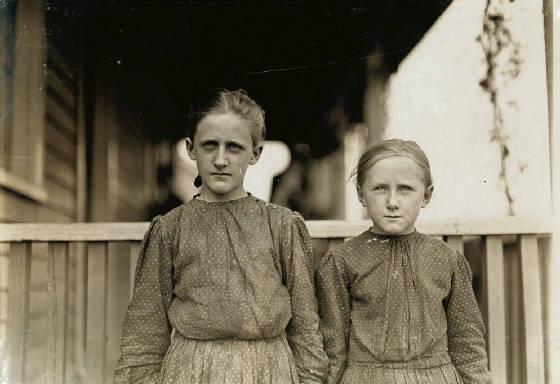
Lewis Hine caption: Oldest girl, Minnie Carpenter, House 53 Loray Mill, Gastonia, N.C. Spinner. Makes fifty cents a day for 10 hours. Works four sides. Younger girl works irregularly. Location: Gastonia, North Carolina, November 1908.
“She (Mattie) was a good Christian woman and she provided for all of us children. I don’t ever remember her going to bed without get on her knees to pray. She preached it to all of her children.” -Cramer McDaniel, son of Mattie Carpenter
This photo of Minnie and Mattie was the first one I chose to work on after I completed the search for Addie Card. As you can see, only Minnie was identified by Hine.
After a month of painstaking research, I obtained a copy of Minnie’s obituary. She died more than 30 years ago, single, with no children. A nephew, Cramer McDaniel of Gastonia, was listed as one of the survivors. In the Internet white pages, I found a person with the same name living in Gastonia. I called him, and he was the right person. He expressed great surprise about the photograph, and was very pleased when I told him I would send him a copy. I thanked him, dropped the photo in the mail, and called him three weeks later. He said excitedly: “I was hoping you would call me sooner. I’ve got some incredible news for you. The other girl in the photo is my mother.”
I guess I should have guessed that the two girls were sisters. Mr. McDaniel was elated to receive the photo of his mother, and I realized that the possibility of repeating this story with other families, that is, sending them photos of their ancestors that they had never seen before, was reason enough to proceed with the project.
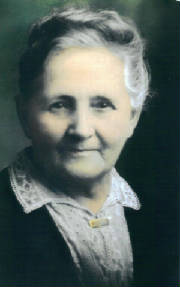
I had started my research on this photo by looking up Minnie Carpenter in the 1910 census. I found her right away, and it was a strange feeling to see her listed, along with her parents and siblings, as if this confirmed to me that she was a real person. I followed her through the 1930 census, which is the last one currently available to the public. And then I got very lucky. Because Minnie never married, I found her, still Minnie Carpenter, in the Social Security Death Index. She died in 1973. So I contacted the library in Gastonia, and they sent me a copy of her obituary from their newspaper archives.
Minnie Mae (or May) Carpenter was born on October 7, 1896, in Lincolnton, North Carolina, and Martha Rosanna “Mattie” Carpenter was born June 12, 1898. They were the daughters of Henry and Mary Carpenter. In the 1900 census, they are living in Gastonia. The two oldest children are working in a textile mill, probably the Loray Cotton Mill, one of the largest textile mills in the South. In the 1910 census, three children are at home, including Minnie and Mattie. In 1920, Minnie is the only child listed at home. The census was recorded on January 17, and exactly six months later, Henry passed away. Mary died in 1953.

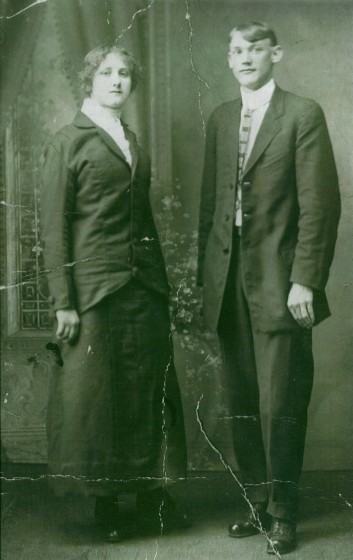
In 1930, Mattie, now married to Thomas McDaniel, is living on South King Street, in Gastonia, with six children. Also in the home are Mattie’s mother Mary, and sister Minnie. Mattie’s husband and her oldest son Albert, 15 years old, are working at the cotton mill, as is Minnie.
Thomas died just four years later, from chronic health problems following an accident. Mattie did not remarry. She died on her 83rd birthday, June 12, 1981. Minnie died on July 15, 1973, at the age of 76, the obituary stating that she was a retiree from Firestone Textiles, which bought the Loray Cotton Mill in the 1930s.
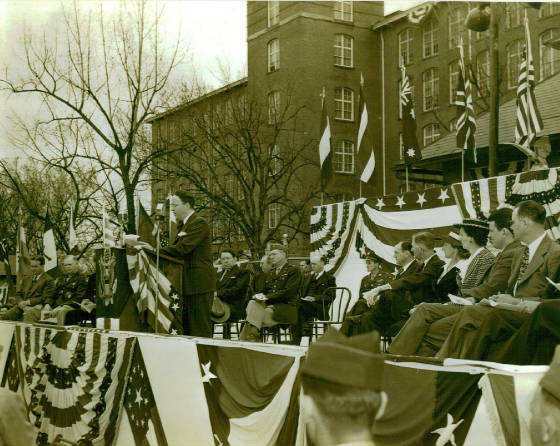
Edited interview with Cramer McDaniel (CM), son of Mattie Carpenter and nephew of Minnie Carpenter. Conducted by Joe Manning (JM), on September 1, 2006. Transcribed by Seunghee Cha and edited by Manning.
JM: I’ve got information that shows that your mother was born June 12th, 1898, in Lincolnton, North Carolina. Does that sound about right?
CM: Yes, exactly right.
JM: I found your family in the 1930 census, and it lists you as eight years old and living on South King Street.
CM: That’s right.
JM: And it looks like about two doors down is your Aunt Minnie, and her mother Mary Carpenter.
CM: They lived in another neighborhood until my grandfather died, and then they moved in with us. That was about 1921, which was the year I was born.
JM: What kind of a house was it?
CM: Oh, it was just a mill house, you know. Back then, the Loray Mill owned all these houses. Then Firestone bought them in ’35. And then they started selling the houses around ’47 or ’48.
JM: So you must have been living near the mill?
CM: We weren’t too far from it, about five blocks away.
JM: Did you ever work at the mill?
CM: Yes, I did. I retired from there. I went to work there when it was Firestone.
JM: How old were you when you started working there?
CM: I was sixteen, I believe.
JM: And what were you doing there?
CM: When I first went in there, I was cleaning. Then I started overhauling frames, and then I started doing mechanic work on the machines. After the war, I came back and then went to Pittsburgh, Pennsylvania, in ’48 to ’49, and was in refrigeration and air conditioning. Me and a guy opened a place, but there wasn’t much air conditioning business then, and we didn’t do too good. And so we started doing electrical work and refrigeration for a company. But I finally went back to Firestone, and I did air conditioning, refrigeration and electrical work for them.
JM: You would have been about seven years old when they had that the 1929 strike at Loray Mill. Do you remember anything about that?
CM: Well, I went to grammar school, and the school was about a block from the mill. They brought the National Guard in there. I remember that.
JM: Do you remember your family striking?
CM: No, I don’t remember. But I don’t think my family struck.
JM: Your mother was working there at the time?
CM: Yeah, and my father, too.
JM: What kind of work did your mother do?
CM: She did all kinds of work. She was in the yarn department. I don’t know what all she did.
JM: Did she ever talk about it much when she got older?
CM: Well, not about when she worked there when she was a girl. But she still worked there when I went to work there.
JM: In her obituary, it said that your Aunt Minnie worked there her whole life.
CM: Yeah, I guess that’s the only job that she ever had.
JM: And she never got married?
CM: No, she never did get married.
JM: Do you remember your Aunt Minnie as being a happy person?
CM: Oh yes, she was happy. And she was just like a mother to me. I had Minnie and my mother’s mother living with us, so it was like I had three mothers.
JM: Do you think your mother was happy in her job?
CM: Oh yes, she was happy, because she had six children. You had to assume she had to have a happy family, you know?
JM: So she was working, and your father was working, and still had all those children. How did she manage?
CM: I don’t know. Back then, you didn’t make any money much. But we made it, we made it good. We had a good family. We were a good Christian family. The Lord looked after us.
JM: Did you do most of your playing outside right around the mill?
CM: Not around the mill, but around our neighborhood, about five blocks away. Back then we didn’t have any money to buy toys or nothing like that. We made our own toys.
JM: Did everybody you knew around that neighborhood work at the mill?
CM: Oh yes, everybody in the neighborhood, ‘cause the mill owned the houses. And the rent, by the way, was real cheap.
JM: Did they have a company store?
CM: No, not then. At one time, I think they did.
JM: According to the records I have, Minnie was born October 7, 1896, and died July 1973.
CM: That’s sounds right. She died when we were taking a vacation. We had to turn around and come back.
JM: And she was still living with your mother then?
CM: Oh, yeah.
JM: I understand that the mill is now being turned into condominiums.
CM: Well, it’s not done. I don’t know what they’re going to do about it. It looks bad right now. They say it’s going to be a historical place. I still live in one of those houses.
JM: So you live in a mill house?
CM: It was at one time. I’ve remodeled it.
JM: Minnie lived a long time, she lived her whole life with your mother, and she worked at the same place all those years. That’s kind of interesting that she did the same thing all of her life.
CM: Well, it was a little different for me. I had a job where I did a little bit of everything. And I was in the Navy in World War II, and I even worked on the railroad a little while. I made five dollars a day.
JM: When did you retire from Firestone?
CM: December 1982.
JM: Did they give you a fairly decent retirement?
CM: Well, it’s better than nothing, you know. They’ve got a union in there now, and they’ve got better benefits than they did when I was working there.
JM: And they’re located in a different place now, right?
CM: Yeah. They built a new plant in King’s Mountain, right off Interstate 85.
JM: What are some of the good things you remember about your mother?
CM: Oh, she was a good Christian woman and she provided for all of us children. I don’t ever remember her going to bed without get on her knees to pray. She preached it to all of her children.
JM: And your father?
CM: The same.
JM: And Minnie?
CM: Minnie, too. Yeah, she was a good Christian. All of them were Christians, a Christian family. You didn’t hear nothing out of the way in our family. No cursing or nothing like that. The Lord provided for us and we thanked Him for it.
JM: Did you know that the man who took the photograph was working for the National Child Labor Committee? They were a group that was trying to get more laws passed to prohibit companies from taking advantage of children. So when people look at the picture of your mother and your Aunt Minnie, do you think there’s any reason to feel sorry for them?
CM: Well, I don’t know. They always seemed to be happy people. They were Christians, you know.

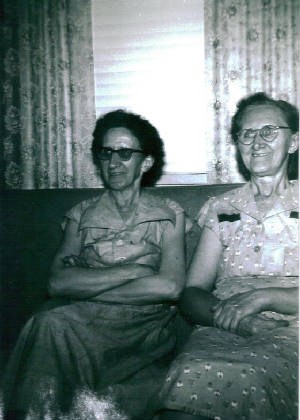
*Story published in 2007.